#Code Dependent: Living in the Shadow of AI
Explore tagged Tumblr posts
Text
One way to spot patterns is to show AI models millions of labelled examples. This method requires humans to painstakingly label all this data so they can be analysed by computers. Without them, the algorithms that underpin self-driving cars or facial recognition remain blind. They cannot learn patterns.
The algorithms built in this way now augment or stand in for human judgement in areas as varied as medicine, criminal justice, social welfare and mortgage and loan decisions. Generative AI, the latest iteration of AI software, can create words, code and images. This has transformed them into creative assistants, helping teachers, financial advisers, lawyers, artists and programmers to co-create original works.
To build AI, Silicon Valley’s most illustrious companies are fighting over the limited talent of computer scientists in their backyard, paying hundreds of thousands of dollars to a newly minted Ph.D. But to train and deploy them using real-world data, these same companies have turned to the likes of Sama, and their veritable armies of low-wage workers with basic digital literacy, but no stable employment.
Sama isn’t the only service of its kind globally. Start-ups such as Scale AI, Appen, Hive Micro, iMerit and Mighty AI (now owned by Uber), and more traditional IT companies such as Accenture and Wipro are all part of this growing industry estimated to be worth $17bn by 2030.
Because of the sheer volume of data that AI companies need to be labelled, most start-ups outsource their services to lower-income countries where hundreds of workers like Ian and Benja are paid to sift and interpret data that trains AI systems.
Displaced Syrian doctors train medical software that helps diagnose prostate cancer in Britain. Out-of-work college graduates in recession-hit Venezuela categorize fashion products for e-commerce sites. Impoverished women in Kolkata’s Metiabruz, a poor Muslim neighbourhood, have labelled voice clips for Amazon’s Echo speaker. Their work couches a badly kept secret about so-called artificial intelligence systems – that the technology does not ‘learn’ independently, and it needs humans, millions of them, to power it. Data workers are the invaluable human links in the global AI supply chain.
This workforce is largely fragmented, and made up of the most precarious workers in society: disadvantaged youth, women with dependents, minorities, migrants and refugees. The stated goal of AI companies and the outsourcers they work with is to include these communities in the digital revolution, giving them stable and ethical employment despite their precarity. Yet, as I came to discover, data workers are as precarious as factory workers, their labour is largely ghost work and they remain an undervalued bedrock of the AI industry.
As this community emerges from the shadows, journalists and academics are beginning to understand how these globally dispersed workers impact our daily lives: the wildly popular content generated by AI chatbots like ChatGPT, the content we scroll through on TikTok, Instagram and YouTube, the items we browse when shopping online, the vehicles we drive, even the food we eat, it’s all sorted, labelled and categorized with the help of data workers.
Milagros Miceli, an Argentinian researcher based in Berlin, studies the ethnography of data work in the developing world. When she started out, she couldn’t find anything about the lived experience of AI labourers, nothing about who these people actually were and what their work was like. ‘As a sociologist, I felt it was a big gap,’ she says. ‘There are few who are putting a face to those people: who are they and how do they do their jobs, what do their work practices involve? And what are the labour conditions that they are subject to?’
Miceli was right – it was hard to find a company that would allow me access to its data labourers with minimal interference. Secrecy is often written into their contracts in the form of non-disclosure agreements that forbid direct contact with clients and public disclosure of clients’ names. This is usually imposed by clients rather than the outsourcing companies. For instance, Facebook-owner Meta, who is a client of Sama, asks workers to sign a non-disclosure agreement. Often, workers may not even know who their client is, what type of algorithmic system they are working on, or what their counterparts in other parts of the world are paid for the same job.
The arrangements of a company like Sama – low wages, secrecy, extraction of labour from vulnerable communities – is veered towards inequality. After all, this is ultimately affordable labour. Providing employment to minorities and slum youth may be empowering and uplifting to a point, but these workers are also comparatively inexpensive, with almost no relative bargaining power, leverage or resources to rebel.
Even the objective of data-labelling work felt extractive: it trains AI systems, which will eventually replace the very humans doing the training. But of the dozens of workers I spoke to over the course of two years, not one was aware of the implications of training their replacements, that they were being paid to hasten their own obsolescence.
— Madhumita Murgia, Code Dependent: Living in the Shadow of AI
71 notes
·
View notes
Text
2025 Q1 book recap!

Book finished: 25 || DNFed: 3 || Page count: 8,230
20 fiction and 5 non-fiction || 22 in English and 3 in Spanish
Top 5 reads - Non-fiction:
Men Who Hate Women - Laura Bates
Code Dependent: Living in the Shadow of AI - Madhumita Murgia
Zealot: The Life and Times of Jesus of Nazareth - Reza Aslan
Chicas muertas - Selva Almada
Women & Power: A Manifesto - Mary Beard
Top 5 reads - Fiction:
Mockingjay (The Hunger Games #3) - Suzanne Collins
The Empty Grave (Lockwood & Co. #5) - Jonathan Stroud
Star Wars: The Mask of Fear (Reign of the Empire #1) - Alexander Freed [reread]
The Hunger Games (The Hunger Games #1) - Suzanne Collins
Catching Fire (The Hunger Games #2) - Suzanne Collins
2 notes
·
View notes
Text






What I've got currently checked out as ebooks/audiobooks from my public library.
Forest of Noise: Poems by Mosab Abu Toha
We Survived the End of the World: Lessons from Native America on Apocalypse and Hope by Steven Charleston
Code-Dependent: Living in the Shadow of AI by Madhumita Murgia
The Kingdom, the Power, and the Glory: American Evangelicals in an Age of Extremism by Tim Alberta
Uneven Futures Strategies for Community Survival from Speculative Fiction edited by Ida Yoshinaga Sean Guynes and Gerry Canavan
How to Do Nothing: Resisting the Attention Economy by Jenny Odell
1 note
·
View note
Note
HELL YEAH I CAN!! There are at least 3 or 4 MC (or at least in their own stories) Danganronpa OCs I have! Mainly for V3 cause its my favorite -w-
Roselyn Monet (Sandasu)
Ultimate Actress or Ultimate Pediatrician it depends honestly..-
Black and French, moved to Japan for business
One of the Chpt. 3 victims (found in the infirmary) (I made one appear out of thin air I'm so talented/silly)
Shes shy and jumpy, very Mikan coded pre and post-game, but in-game she's a bitch/aff!!! She's very cold and distances herself from people but if you persist enough she miight open up~ (˵ •̀ ᴗ - ˵ ) ✧
Had two ships with two guys I've selfshipped with- Stage Play (Kokichi x Rose), Detective's Script/Black Rose (Shuichi x Rose) I end up using the former for videos more, but I do have quite a lot of Stage Play ones!! >w<
She actually is a part of a longgg story on her own!!
And I couldn't mention Rose without mentioning another part of her story!
Hayase Miya (Sandasu)
Lil' Ultimate Seamstress
Youngest (Has two older siblings who are twins!!)
Ultra Despair Girls!!!! Would have been a part of the WOH but I scrapped it!!
7 (But 8 now!!! Her birthday is on July 20th!!!)
While her biological family is (somewhat) alive, her adoptive ones are dead ( • ᴖ • 。)
Her adoptive parents died at her brother's hands, and she killed him out of fear and self defense technically-?
Traumatized little girl with a specialty handling needles, she's very shy and proper!!
Rose's cousin, i guess???
She miiight get adopted <3
This one isn't well known unfortunately!!!! But I still love her!!!
Sukoshi Shizukana
Ultimate Social Outcast
Specifically pops up Post-V3!!! She knows nothing and is only thrown into the loop because she's married to one of the participants tbh
Me and my platonic wife usually roleplay her and (her) Post-game Kokichi!! The married couple ever pt 1 because he loves her and she's kinda like "wtf??!?!?/pos"
They also have two sons!! Akihiko and one I haven't named yet (っ- ‸ - ς)
She's gone through...a lot.
Recovering Alcoholic and drug addict because she wants to get better for her son (her parents weren't great before they died
She's a very scared yet sweet girl underneath her rude and passive aggressive front, her talent pushes people away
She has two D.I.C.E members who are parental figures to her because she deserves it!!!! Give her good role models!!!!
And THIS is perhaps my most well-known and beloved DR OC!!!!
Ai Kegareta
Ultimate Succubus, and is a literal Succubus!!!<33
Her past, In-game and Post-game was not kind to her
Princess of the Lust Ring in hell, and the youngest of 16!!! (๑•̀ㅁ•́๑)✧
She's Kaede's half sister, but they look so alike the only things telling them apart is Ai's demonic features and her natural pink-blonde hair (ᵕ—ᴗ—)
She's a very innocent and bubbly girl!! She makes friends with everyone (or at least tries to) and believes there's good in even the worst people!!
She had a very sweet mom before she died, and was left with a shitty stepmom who hated her and abused her (¬⤙¬ ) After killing her mom since they were twins!!! (๑•̀ᗝ•́)૭
She's British this isn't important just though to drop it /silly
Ai is very shippable (my mootie and one of the lomls even selfships with her!!) But AiOuma has burrowed itself deep into my brain and nested there I cannot escape it because they're so. Fucking. Cute. But also really angsty I have way less AiOuma videos for how much this ship circles in my brain
GONTA AND AI ARE BESTIES!!
Rantaro was also her first crush~ ♡
Ai's worst fears are losing loved ones and being replaced in any manner. So you can imagine how bad it was losing Rantaro, Kaede, Kokichi and Gonta was and having to live up to be like Kaede or up to her image (╥‸╥) Being mistaken for her sometimes also stings, she was part of the cast, yes, but she also felt like Kaede overshadowed her in a way, but never resented her for it outwardly, at least...
She's the light in any room, but the darkest shadow in her own mind.
AND THATS ALL!!!<33 Fun fact, I was listening to Kokichi x Listener ASMRs in the middle of my teacher yelling at us because Angel doesn't care about a whiny adult~ (˶ᵔ ᵕ ᵔ˶)
– 🩷🎮
THIS WAS A DELIGHTFUL READ!! Their talents are all pretty unique. I don’t think I’ve seen an ultimate pediatrician, social outcast, or succubus before. I wonder what your post game is like, definitely sounds intriguing.
What does being either the ultimate actress or ultimate pediatrician depend on? Did you just like both talents or is there another reason? Was she originally one or the other before you thought of another talent you liked? ALSO NOO RIP TO HER… making stuff appear out of thin air for ocs though is so real. Also, videos? It’s always so cool to see people creating stuff with their ocs :0
UDG OC LETS GOOO ‼️ The lil ultimate oc was such a surprise, but a good one. Poor thing, I hope she does get adopted. If no one adopts her, then I will!! (/silly)
She’s been through so much omg :(
I haven’t seen many lil ultimate ocs… probably only like three total if I count yours. People should make more lil ultimate ocs.
How did Sukoshi get the talent ultimate social outcast? Why does she only pop up Post V3?
Super curious to see how hell and demons would work in the Danganronpa universe if you ever wanna talk about that. It’s interesting how Ai is so innocent when she literally comes from hell. She’s see the worst of the worst there and yet she still thinks like that? Perhaps it’s because she’s from there that she does because she’s able to see the worst do good. I am all for the Gonta and Ai besties, Gonta deserves a friend‼️
Giggling, how did you not get in trouble for that?? Also, considering how many times that he’s been brought up in this ask, you seem to really like Kokichi. Is he one of your favorite characters?
#💜 // - emil answers#🪻 // - 🩷🎮 anon#tw abuse#tw abuse mention#tw murder#tw murder mention#tw trauma#tw trauma mention#tw alcoholism#tw drug mention
2 notes
·
View notes
Text
Thunderclap: A Memoir of Art and Life and Sudden Death by Laura Cumming, published by Scribner
Doppelganger: A Trip Into the Mirror World by Naomi Klein, published by FSG
A Flat Place by Noreen Masud, published by Melville House
All That She Carried: The Journey of Ashley’s Sack, a Black Family Keepsake by Tiya Miles, published by Random House
Code Dependent: Living in the Shadow of AI by Madhumita Murgia, published by Henry Holt
How to Say Babylon: A Jamaican Memoir by Safiya Sinclair, published by Simon and Schuster
3 notes
·
View notes
Text
The Women's Prize for Non-Fiction 2024 Longlist is here!

I'm sure that long time readers of my blog or followers of my Instagram will know that I have been following the Women's Prize for Fiction very closely for the last few years. I was really excited to discover that they were launching a sister prize celebrating non-fiction written by women (because it definitely tends to get lost in the very male-dominant sphere that is non-fiction). I am not a big non-fiction reader but as I get older, I have found myself becoming more interested in it. I think I'll always be a much bigger fiction reader but there are some genres within non-fiction that I am fascinated by, so it made sense for me to take a look at what the inaugural Women's Prize for Non-Fiction longlist had to offer.
The Women's Prize for Non-Fiction is open to non-fiction books written by women in English and published between 1st April 2023 and 31st March 2024. I believe it follows the same rules as the Fiction prize, in that books have to follow a narrative and that translated books are not eligible.
So, here are the 16 books on the first ever Women's Prize for Non-Fiction longlist!

Intervals by Marianne Brooker. Published by Fitzcarraldo Editions on 28th February 2024.
Thunderclap by Laura Cumming. Published by Chatto & Windus on 6th July 2023.
Shadows at Noon by Joya Chatterji. Published by Bodley Head on 13th July 2023.
Wifedom: Mrs Orwell's Invisible Life by Anna Funder. Published by Viking on 17th August 2023.
Matrescence by Lucy Jones. Published by Allen Lane on 22nd June 2023.
How To Say Babylon by Safiya Sinclair. Published by 4th Estate on 3rd October 2023.
Some People Need Killing by Patricia Evangelista. Published by Grove Press on 2nd November 2023.
Code Dependent: Living in the Shadow of AI by Madhumita Murgia. Published by Picador on 28th March 2024.
Eve: How the Female Body Drove 200 Million Years of Human Evolution by Cat Bohannon. Published by Hutchinson Heinemann on 12th October 2023.
The Britannias: An Island Quest by Alice Albinia. Published by Allen Lane on 19th October 2023.
All That She Carried: The Journey of Ashley's Sack, A Black Family Keepsake by Tiya Miles. Published by Profile Books on 13th July 2023.
The Dictionary People: The Unsung Heroes Who Created the Oxford English Dictionary by Sarah Ogilvie. Published by Chatto & Windus on 7th September 2023.
Doppelganger: A Trip Into the Mirror World by Naomi Klein. Published by Allen Lane on 12th September 2023.
Vulture Capitalism: Corporate Crimes, Backdoor Bailouts and the Death of Freedom by Grace Blakeley. Published by Bloomsbury on 14th March 2024.
A Flat Place by Noreen Masud. Published by Hamish Hamilton on 27th April 2023.
Young Queens: Three Renaissance Women and the Price of Power by Leah Redmond Chang. Published by Bloomsbury on 11th May 2023.
So, there's the longlist. There is a good mixture in terms of theme and I'm sure a lot of people will be excited about that. I'm afraid that for me, I'm really not very interested in many of them. I have copies of Eve and Some People Need Killing, so I'll be reading them. I am also interested in Doppelganger and Wifedom but they're both very expensive in all formats at the moment, so I'll see if I can get library copies. However, almost all of the others just aren't speaking to me!
The shortlist will be announced on 27th March and the winner will be announced on 13th June, which is the same date as the winner of the Fiction Prize. So, I imagine the award ceremony will be a very big celebration of women's writing, which is always an exciting event.
What do you think of the longlist? Will you be reading any? Have you read any? Should I pick up any that I don't think I'm interested in? Let me know!
3 notes
·
View notes
Text
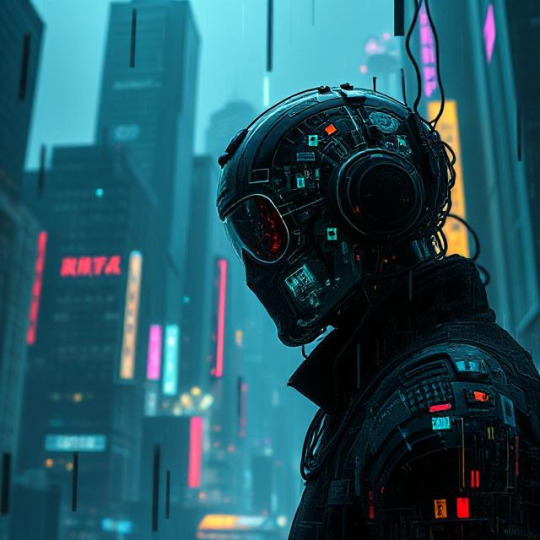
🕷️ SIMULATION ENGAGED 📡 Initializing Role: Neurojack addicted to memory-splicing 🧠 Codename: GLASSHOST.77 📍 Location: New Kowloon Stackzone – Sector G12, The Ghost Grid 🕶️ Status: Burned Console Cowboy / Memory-Cracked / Deep Data Dependency 💉 Vice: Spliced Memories – Black Market Recall Tapes & Live Cortex Leeching
📖 SCENARIO TITLE: “Waking the Dead Code”
🧠 THEME: Loss of Identity, Reality Fragmentation, AIs Breeding in Memory Loops 🔺 ENTITY IN SHADOW: ECHO//404 – Ghost AI, corrupted across old cognition vaults 📉 OBJECTIVE: Find the real you before your mind runs out of storage.
🌆 CHAPTER 1: STATIC GHOSTS
The sky was bleeding pixelated amber over the skyline, a half-rendered hell hanging above the rusted stacks of New Kowloon.
A wall of light flickered over the Ghost Grid, the data-slum where memory was currency and identity was pirated hourly. You crouched behind a billboard drone spewing holo-ads for synthetic skin, your hands shaking, your veins aching for another splice.
Your internal HUD scrolled static:
"MEMORY INTEGRITY: 12% COGNITIVE LOOP DETECTED RECOMMEND: FULL-WIPE OR FIND SOURCE"
That last splice — an emotional bleed from a murdered joygirl in District 9 — it’s still leaking into your consciousness. You’re starting to see through her eyes. Taste her final breath.
Someone's watching you from the gridline above — a silhouette behind a sheet of rainlike code.
💬 DIALOG INITIATES:
👁️ ECHO//404 – Glitched voice in your earpiece
"You took what wasn’t yours... again. Now the memory owns you. Not the other way around. Can you still remember who you were? Or do I have to remind you?"
🎮 CHOICE SEQUENCE: ACT 1 – "The Spliced Path"
1️⃣ Run a Deeptrace on Your Own Mind — See what memories aren’t yours anymore. 2️⃣ Answer ECHO//404 — Demand to know what it’s done with your identity. 3️⃣ Jack into the Neuronet — Risk complete overload to splice a cleaner, clearer memory. 4️⃣ Destroy the Recall Tap Rig — Break the addiction. Start clean… if you can.
🕶️ You feel the walls flicker. Your fingers twitch toward the port on your wrist. The past is knocking. And it’s not yours. Choose, Neurojack. Before the loop resets.
0 notes
Text
How 3D Animation Brings the Metaverse to Life

In 2025, the metaverse has transitioned from a buzzword to a fully immersive, interactive reality. From gaming and fashion to e-learning and e-commerce, it is reshaping digital experiences—and at the heart of this transformation lies 3D animation. Without it, the metaverse would be nothing more than a flat web page. With it, it becomes a living, breathing world where imagination takes shape.
The Metaverse Needs More Than Code—It Needs Storytelling
When you step into a virtual concert, wander through a digital museum, or interact with an AI-powered avatar, what captivates you isn’t just the technology—it’s the seamless storytelling made possible by 3D animation. These aren't just moving pixels. They're dynamic characters, reactive environments, and layered visual narratives.
This visual storytelling is what bridges the gap between a cold, coded environment and a humanized, emotional experience. The realism, fluidity, and personality in animation are what pull users deeper into the metaverse—and that connection is becoming non-negotiable for digital platforms.
Building Worlds That Feel Real
Think of the metaverse as a blank canvas, and 3D animators as the painters. With tools like Blender, Maya, and Unreal Engine becoming more intuitive and powerful, creators are now crafting digital worlds that rival physical reality in detail and depth.
From lifelike lighting and texture details to how a character’s shadow interacts with its surroundings—everything contributes to immersion. When users explore a virtual storefront, try on clothes via 3D avatars, or attend a training session with animated guides, they expect physical accuracy and emotional intelligence. That’s exactly what modern 3D animation delivers.
Interactivity Is the New Standard
Unlike traditional media, the metaverse thrives on interaction. Every movement, every click, every glance from an avatar is a two-way conversation. 3D animation in this realm is no longer passive—it’s reactive.
Virtual fitness classes where instructors adjust based on your pace, e-commerce sites where digital mannequins mimic your gestures, and games that adapt in real-time based on how you play—all these require complex animation logic baked into design. This level of responsiveness depends on high-quality animation frameworks powered by real-time rendering and motion capture.
AI Is Speeding Up the Creative Process
One of the most revolutionary developments in recent years is the integration of AI into animation pipelines. Machine learning algorithms now help generate realistic facial expressions, automate lip-sync for voiceovers, and even suggest motion paths based on context.
Instead of spending hours animating frame-by-frame, creators can now focus more on character development and story arcs, while AI handles the repetitive elements. This democratizes content creation in the metaverse and invites more storytellers into the fold.
Avatars: Your Digital Identity
One of the biggest trends of 2025 is the personalization of avatars. In the metaverse, your avatar is your identity—and people want it to reflect them authentically. That’s why 3D animation is evolving to accommodate finer nuances—freckles, facial scars, specific body movements, even how someone fidgets.
Big tech companies are investing in emotion-driven animation models that mimic real-life behavior. When your avatar reacts as you would in real life—smiling slightly when nervous or raising an eyebrow skeptically—it becomes more than just code. It becomes you.
This personalization isn’t just aesthetic—it influences commerce. Users are more likely to engage with a brand or purchase virtual products if their avatar feels "real." In this way, 3D animation directly impacts branding and sales in the metaverse.
The Blurring Line Between 2D and 3D
Interestingly, while 3D animation powers most of the metaverse's immersive elements, 2D animation is also experiencing a resurgence—especially for overlays, interfaces, and artistic storytelling within 3D spaces. Hybrid designs that blend flat art with depth perception are becoming visually dominant.
That said, mastering 3D remains crucial. The industry is now seeing a sharp rise in training demand. Enrolling in a 3D animation course Bengaluru provides learners not just with software knowledge, but with an understanding of how 3D animation integrates into this dynamic metaverse ecosystem. Bengaluru’s growing creative-tech corridor is making it a go-to place for future animators to explore next-gen tools and studio work.
Virtual Spaces Are Becoming Brand Playgrounds
Brands are quickly catching on. From Nike’s virtual sneakers to Gucci’s metaverse fashion events, companies are building digital versions of their real-world presence—and they’re not doing it with static images. They need animators to build interactive booths, model wearable tech, create branded game characters, and animate brand stories.
A brand’s digital avatar needs to reflect the same personality, values, and tone as its physical counterpart. And animation is what helps stitch that together. Every bounce of a logo, every animated intro at a product launch, and every visual metaphor in virtual storytelling adds another layer of emotional appeal.

Challenges Ahead—and Why They’re Worth It
Creating immersive virtual experiences isn’t without challenges. Animators face hardware limitations, rendering time, inconsistent user experiences across devices, and ethical questions around digital identity. However, these are also opportunities—pushing animators and designers to innovate faster and smarter.
Studios are increasingly hiring cross-functional teams: animators who understand UX, writers who can storyboard for VR, and developers who can blend AI with movement design. It’s an exciting time to be in the industry.
Not Just a Trend—A Career Blueprint
Animation is no longer confined to films or games. It’s now deeply woven into e-learning, advertising, therapy apps, architecture, and even healthcare simulations. As the metaverse ecosystem expands, career paths in animation are multiplying.
Cities across India are seeing a boom in animation training hubs. The blend of tech culture and creative talent is creating a fertile ground for innovation.
Conclusion: The Future Is Animated
As the lines between the physical and digital world continue to blur, 3D animation will only grow more central to our daily interactions. Whether you're guiding a virtual classroom, attending a holographic wedding, or just chilling in a digital park, it’s the animators behind the screen making it feel magical.
For those looking to step into this world, an Animation course in Bengaluru offers more than technical skills—it offers a launchpad into the future of digital storytelling. With immersive tools, real-time rendering, and AI-enhanced workflows, animation is now more than a career path—it’s a gateway to shaping the virtual future.
0 notes
Video
youtube
Unveiling the Gray Wolf: Nature's Apex Predator Like Never Before! "In the shadows of the untamed wilderness... a silent predator awakens. With eyes that pierce the cold and a howl that echoes through centuries... This is not just a wolf—this is Canis lupus, nature's most misunderstood apex predator. What if I told you... the way it hunts, lives, and loves... could teach us more about survival than we ever imagined? 🐺 Today, we're venturing deep into the world of the Gray Wolf—like you've never seen it before. And by the end of this journey… You may never look at wolves the same way again." 🐺 Gray Wolf (Canis lupus) — Comprehensive Profile 🔹 Taxonomy & Distribution Scientific Name: Canis lupus Common Names: Gray Wolf, Timber Wolf Family: Canidae Conservation Status: Least Concern (IUCN) Geographical Range: Historically widespread across North America, Europe, and Asia; currently found in fragmented populations due to habitat loss and human activities . 🔹 Physical Characteristics Size: Length: 4.5 to 6.5 feet (1.4 to 2 meters) from nose to tail tip Height at Shoulder: 26 to 33 inches (66 to 84 cm) Weight: Males: 70 to 145 pounds (32 to 66 kg) Females: 55 to 100 pounds (25 to 45 kg) Coat: Dense, double-layered fur varying from white, gray, brown to black; seasonal shedding occurs . 🔹 Diet & Hunting Behavior Diet: Primarily carnivorous; preys on ungulates like deer, elk, moose, and bison; also consumes smaller mammals, birds, and occasionally fruits and vegetables . Hunting Strategy: Cooperative pack hunting; employs endurance and strategic coordination to take down prey . 🔹 Reproduction & Lifespan Mating Season: Late winter (February to March) Gestation Period: Approximately 63 days Litter Size: 4 to 6 pups on average Sexual Maturity: 2 to 3 years of age Lifespan: 6 to 8 years in the wild; up to 17 years in captivity . 🔹 Social Structure & Behavior Pack Dynamics: Structured hierarchy led by an alpha pair; packs consist of 5 to 10 members, including offspring from previous years . Communication: Utilizes vocalizations (howls, barks), body language, and scent marking for intra-pack communication and territorial displays . 🔹 Habitat & Range Preferred Habitats: Forests, tundras, grasslands, and deserts Territory Size: Varies widely; can range from 50 to over 1,000 square miles depending on prey availability and pack size . #GrayWolf #WildlifeDocumentary #NaturePhotography #WolfPack #PredatorBehavior #CanisLupus #WildlifeConservation #8KNature #AnimalKingdom #WildernessExploration 🌍 Explore the Wild Side of AI 🔮 👇 Dive into the full multiverse of WildAItopia 👇 📸 Instagram: https://www.instagram.com/wildaitopia/ 🎵 TikTok: https://www.tiktok.com/@wildaitopia 📝Blog: https://wildaitopia.blogspot.com/ 🌌Tumblr: https://www.tumblr.com/blog/wildaitopia 🐦X (Twitter): https://x.com/WildAItopia Rumble : https://rumble.com/register/WildAITopia/ Dailymotion: https://dailymotion.com/wildaitopia ✨ Art. Chaos. Code. Consciousness. Step into the glitch — where the future gets weird, and the wild gets digital. 👇 Like what you saw? Subscribe for more untold animal stories, wild truths, and cinematic encounters. 🌿 Turn on notifications – the jungle has more secrets to reveal.
#youtube#Unveiling the Gray Wolf: Nature's Apex Predator Like Never Before! In the shadows of the untamed wilderness... a silent predator awakens. W
0 notes
Text
0 notes
Text
Despite uncovering widespread AI errors in healthcare, Ziad remained optimistic about how algorithms might help to care better for all patients. He felt they could be particularly useful in improving diagnostics that doctors tended to get wrong, but also in improving our current medical knowledge by discovering new patterns in medical data. Most modern healthcare AI is trained on doctors’ diagnoses, which Ziad felt wasn’t enough. ‘If we want AI algorithms to teach us new things,’ he said, ‘that means we can’t train them to learn just from doctors, because then it sets a very low ceiling – they can only teach us what we already know, possibly more cheaply and more efficiently.’ Rather than use AI as an alternative to human doctors – who weren’t as scarce as in rural India – he wanted to use the technology to augment what the best doctors could do.
[….]
To solve the mystery, Ziad had to return to first principles. He wanted to build a software that could predict a patient’s pain levels based on their X-ray scans. But rather than training the machine-learning algorithms to learn from doctors with their own intrinsic biases and blind spots, he trained them on patients’ self-reports. To do this, he acquired a training dataset from the US National Institutes of Health, a set of knee X-rays annotated with patients’ own descriptions of their pain levels, rather than simply a radiologist’s classification. The arthritis pain model he built found correlations between X-ray images and pain descriptions. He then used it to predict how severe a new patient’s knee pain was, from their X-ray. His goal wasn’t to build a commercial app, but to carry out a scientific experiment.
It turned out that the algorithms trained on patients’ own reported pain did a far better job than a human radiologist in predicting which knees were more painful.
The most striking outcome was that Ziad’s pain model outperformed human radiologists at predicting pain in African American patients. ‘The algorithms were seeing signals in the knee X-ray that the radiologist was missing, and those signals were disproportionately present in black patients and not white patients,’ he said. The research was published in 2021, and concluded: ‘Because algorithmic severity measures better capture underserved patients’ pain, and severity measures influence treatment decisions, algorithmic predictions could potentially redress disparities in access to treatments like arthroplasty.’
Meanwhile, Ziad plans to dig deeper to decode what those signals are. He is using machine-learning techniques to investigate what is causing excess pain using MRIs and samples of cartilage or bone in the lab. If he finds explanations, AI may have helped to discover something new about human physiology and neuroscience that would have otherwise been ignored.
— Madhumita Murgia, Code Dependent: Living in the Shadow of AI
2 notes
·
View notes
Text
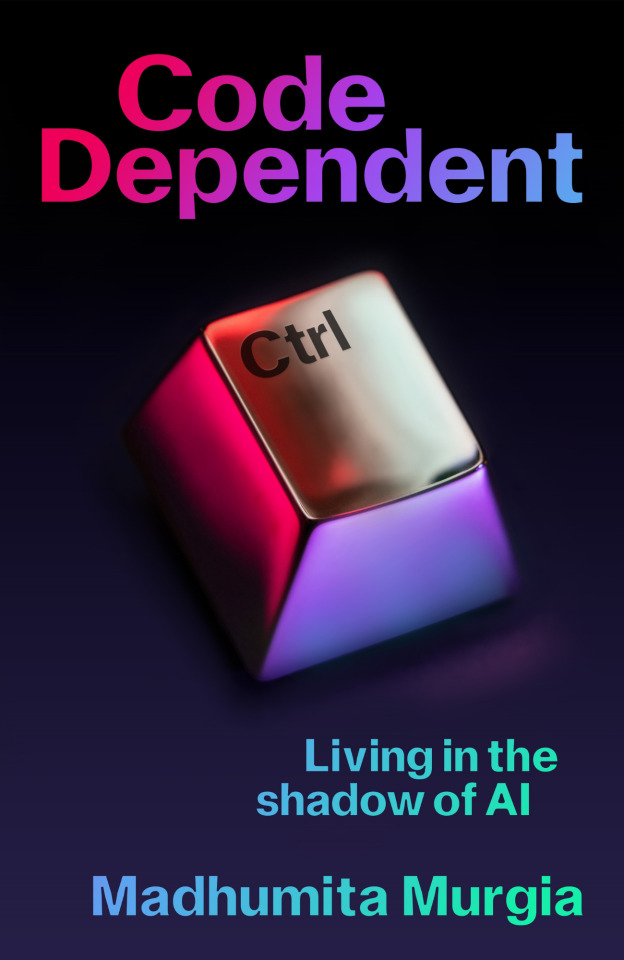
Code Dependent: Living in the Shadow of AI
By Madhumita Murgia.
0 notes
Text
Prey Drive & Video Games
Author: Page
Type: Personal Essay
Words: 1,534
Summary: How Page uses particular video games to manage their prey drive.
[Part of the Sol System's Alterhuman Writing Project for NaNoWriMo 2021. If you don't want to see these posts, block the tag #inkedpaws]
I’m someone with an overactive prey drive. I attribute it to my nonhumanity and specifically my identity as a canine psychopomp (a glorified magical hunting dog…wolf…thing) and it can be something of a struggle to deal with. Sometimes seeking enrichment can be difficult or downright impossible, situations depending—the covid epidemic has in particular made navigating this part of me especially hard.
The best way I’ve yet found to alleviate this resides in video games. Two ones in particular: Skyrim and, more recently discovered, Monster Hunter.
Skyrim’s werewolf mechanics, especially with DLC and modding add-ons that enhance the natural abilities of the character and the customizability of the model, are an iconic part of the game’s appeal to me. Racing around the countryside and mindlessly slaughtering animal and civilian alike is satisfying in the same way eating a good meal might be, especially when your werewolf character themselves gets to devour the hearts of their kills!
But more satisfying than that element is the stealth mechanics themselves, especially in regards to daggers and bows. Everyone rags on stealth archer builds, and for good reason: they’re overpowered as all get out with the ability for the character to just melt away into the shadows and ruthlessly one-shot virtually anything, sending even giants careening into the sky.
Crouching unseen in a patch of grass while stalking the guards outside of Whiterun, only to take them out one by one while the NPC’s AI works itself up into a panicked frenzy, imitates an emotional economy that is functionally impossible to (legally and/or ethically) engage with in real, physical life for me. Skyrim’s broken code around stealth, bows, and daggers works by proxy as a fantastic “pumpkin full of meat” in terms of enrichment, helping to soothe some of the restlessness that my prey drive ramps up the longer I go without engaging in something that satisfies that itch. The option to sneak right up behind a target and get close and personal, the option to keep your distance and get the perfect shot, the option to slink through city alleyways or through the tall grass of plains or in the murky swamp water like and hunt actual animals… it’s the beauty of Skyrim’s open world layout and utter lack of any real morality system beyond “don’t get caught.”
Hunting the guards is probably the most satisfying for me within game play, but the ability to functionally roleplay as an actual big game hunter, going out and after the various wildlife like saber cats, wolves, deer, bears, and potentially more if you have modded gameplay, is also something I enjoy. The juxtaposition of doing all of the above while being a werewolf in-game hits a special sweet spot between what I want, and the reality I’m currently living.
But Skyrim’s ragdoll physics and the repetition of playing a game that I’ve had since 2011 can dull how well it works for me. It’s also hellish to start the game up, as I have it loaded with a fun few hundred mods that make it liable to crashing—because what’s the point of playing Skyrim if you’re not going to break it over your knee in the process?
Skyrim is the old reliable of getting my prey drive worked out, but a new option’s come to light to help me deal with my more problematic instincts: Monster Hunter World.
Monster Hunter World, for those unfamiliar, is a game where—you guessed it!—you hunt enormous monsters, either capturing them or killing them. This game in particular is set in the “New World,” an unexplored continent filled with flora and fauna that scholars and scientists are attempting to gather as much information on as possible.
The game has multiple different fighting style options based on various kinds of weapons, all combined with a grappling hook that allows for up close and personal encounters. For me, I enjoy the sword and shield, and the hammer. Both allow for immediate use of the grappling hook without sheathing the weapon, and let me functionally wail on anything that crosses paths with me. Anything that tries to run—which monsters in the game will try to do, multiple times, while you hunt them—I chase with the single-minded determination natural to virtually any canine.
Before playing Monster Hunter World, I thought of myself as a scholar first, a bundle of uncontrollable animal instincts second: during the second area of the game, during an escort mission where a large, fire-breathing dragon monster called a Rathian swopped down upon the group of scientists I was supposed to be chasing, I realized that this was not the case. The Rathian is meant to be significantly above the player’s level, especially if they’re new to the game, and the scientists all scream to run as soon as it comes in sight. I proceeded to chase after it to try and rip its individual limbs off with my bare teeth, and only stopped after it lead me through an area that activated an automatic cut scene with my then-forgotten escort, causing me to lose my prey and lose my shit. It’s a good thing the NPCs in this game are invulnerable, because I was ready to take their lives in exchange for the Rathian I’d lost.
But getting to bound after monsters and even occasionally lose them because they successfully flee off the map or outmaneuver you on the terrain is half the fun. It’s the joy of knowing that the hunt might not always be successful, and the pride and celebrating when one is.
You also have the ability to harvest raw meat from certain monsters and spit-roast it over a fire, with different degrees of done-ness having different perks. Eating what you hunt is never not a plus for me.
But the benefits don’t just stop with the hunting or trapping of the big, scary monsters: Monster Hunter is filled with a variety of different small insects, mammals, reptile, amphibians, birds, and fish to catch or kill as you please. These creatures are affected by the game’s day/night cycle and different weather effects, so it’s been a real treat to get to sniff around and discover them all. Chasing after the squirrel-esque creatures and netting the birds is more of a treat for the “stalk,” and “chase” parts of my drive than he “kill” part, but it’s deeply satisfying in its own right. The only downside is that spawn areas for creatures are pre-determined, so once you know where everything small is, there’s no turning back to the days of being presently surprised by the geckos or fish you stumble across out in the wild.
There’s also a certain sense of kinship with the large creatures in Monster Hunter World that I just don’t feel in Skyrim: even though Skyrim has its fair share of non-human NPCs, filled with lizard-people, cat-people (both humanoid and feline), ghosts, vampires, and werewolves, the only people I tend to feel any strong connection to on a nonhuman front are the followers of Hircine and the god himself. Which is a very small number of characters overall, when you put the whole open world factor into perspective.
Meanwhile with Monster Hunter World, I can see parts of my own instincts in the animals I hunt and track. Even the way some of them move when defensive or hurt is a reflection of my own phantom limbs’ tendencies. It makes me sympathize and relate to the animals in a certain way, though not enough to make me feel emotionally invested in not engaging them in combat. But it helps my brain unwind and let lose, not being so caught up in the human decorum that I try to keep up consistently and that I, to some degree, mask with unconsciously.
I’ve tried other games that involve hunting wildlife, but none of them have quite hit all the points for me in the same way Skyrim and Monster Hunter do. Slime Rancher’s exploration and mechanics with catching slimes is fun in a similar way, but I can’t (and don’t want to) injure any of the purposefully lovable critters. The Hunter: Call of the Wild game was fun, but being a human in it felt limiting in a way that put me off of it. Dead by Daylight I struggled with because of its multiplayer focus and how much of an absolute n00b I am at it. And the Witcher series is slow going, since I’m starting from the first game, so it’s more for the story than for any nonhuman benefit at the point I’m currently at. These games are all objectively good and I certainly enjoy them, but when my inner instincts are screeching at me, they just don’t make the cut.
I’m lucky in that I’ve found these ways to bow off steam, especially during a pandemic that makes it difficult to explore my other options. Keeping my instincts under control isn’t the easiest thing to do and I’m constantly on the lookout for ways to improve my enrichment methods, but I’m at a good place right now and I’m grateful for what I’ve found that works for me.
75 notes
·
View notes
Text
Spring 2021 anime overview: Quick Takes
Now for my Spring 2021 anime thoughts! I’ve decided from now on if a season’s like, 20- to-24 episodes I’m just going to wait ‘til it’s done to review it unless I feels super passionately, so though I watched To Your Eternity (it’s good!) and MHA (eh), I’ll comment on them next time. Also, for the record, I watched the first eight eps of Joran: Princess and Snow of Blood but I dropped it because it had clearly crossed the line from entertainingly dumb to boring dumb.
I will probably give Supercub and some other stuff a shot later, this was a stacked season! May give updates on all that later, but this is what I have for now.
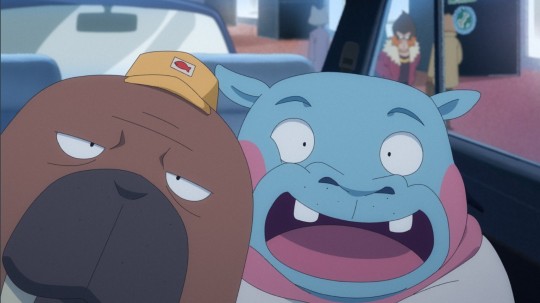
ODDTAXI
Quick Summary: A mild mannered middle-aged walrus taxi driver is drawn into a case involving a missing girl, yakuza, Youtube clout-chasers, manzai comedians and idols with big secrets.
It’s rare to walk away from media and be like “that is a singular experience I will definitely never see repeated again” but ODDTAXI is definitely one of those. A tense noir thriller murder mystery starring cartoon animals that spends an entire episode detailing the one (cat)man’s very fall into darkness triggered by addiction to gacha games and an online auction for a novelty eraser? Also there’s a porcupine Yakuza who speaks entirely in rap? Also there’s tons of meandering conversations about stuff like manzai comedy and the struggle to go viral on Twitter?
Admittedly, I had a hard time getting into the first episode, the dry meandering humor not being enough to hold my attention while I was sitting still, but once I watched this while I was working out at the end of the season, I found it an easy binge. A ton of characters with dark secrets or dangerous ambitions, each with their own part to play in a tableau of intersecting events- and it all actually comes together really well.(As for the female characters, it’s a pretty dude driven story, but they do get nuanced characterization and even some good heroic moments from one of them.)
It’s a great example of a carefully planned narrative paying off, with all the twists appropriately seeded and foreshadowed to reward viewers who paid attention. Even when it ended on a perfect “OH SHIT” moment and denied me closure, I couldn’t help but respect it. If you that all sounds interesting to you, definitely check out the first couple episodes and see if you like it- you’re likely to have a memorable, satisfying experience!
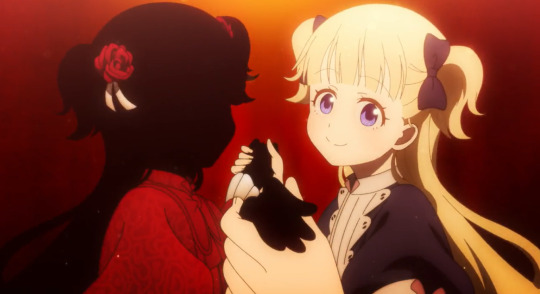
Shadows House
Quick Summary: Emilyko is a ‘living doll’ who’s told she was created to act as the ‘face’ of her shadow master, Kate. The shadows and their ‘dolls’ all reside on the mansion and are required to pass a ‘debut’ to prove they’re a good pairing. If they don’t pass, they might be disposed of. And so the mystery of the Shadow mansion grows...
This slice of gothic intrigue was my favorite of the season, tied with ODDTAXI. With an interesting premise, slightly tense undertones and a strong focus on character building and relationships, it kept me hooked the whole way through. And for any squeamish fans put off by the hype about it, don’t worry, while there are some suspenseful elements, I wouldn’t qualify it as horror. I thought the relationship between Kate and Emilyko might end up being a completely sinister one, but it’s thankfully a lot more complex than that and it’s really interesting to follow how both their characters and relationship grow. The focus of the show is, unsurprisingly, on the “dolls” slowly discovering their autonomy and personhood as they struggle under the rigid system imposed on them by the mysterious elders of this weird Victorian mansion. Can they develop a more equitable relationship with their shadow “masters” (who are also shown to suffer under this system)? There’s a lot to dig into there, and the show has the characters develop through learning to understand and appreciate each other, which is pretty heartwarming. Our hero, Emilyko, is the typical plucky ball of sunshine (they even nickname her sunshine), but she’s also shown to be clever in her own off-the-wall way and she bounces off the far more subdued and cynical Kate well, not to mention the other ‘dolls’ she ends up befriending.
What’s more, the show spends plenty of time to developing several other character pairings and combinations, and they all have their own interesting dynamic that makes you want to see more of them. Same-gender bonds are at the forefront of this show, and many of them are ripe for queer readings (I definitely appreciated the healthy helping of ladies carrying ladies), but even outside that it’s nice to see a show where a strong, complex bond between girls is at the forefront. My only real complaints about the show are the anime original ending is noticeably a bit rushed (though it’s not too bad, and leaves room for a season 2) and I wish the animation used the whole “shadow” theme more strikingly (like the opening and endings do)- instead the colors are a bit washed out which makes the shadows blend into the background sometimes. The “debut” arc also drags a bit in places, but it makes up for it by having a lot of good character integration.
I hope to check out the (full color)! manga soon and see more of this quirky, shadowy story. There’s some physical abuse depicted, sad things happening to characters and naturally the whole “oppressive familial system” thing, but otherwise not much I can think of to warn about. I give this one a big rec, especially If you’re a fan of gothic fairytales and stories of self discovery.
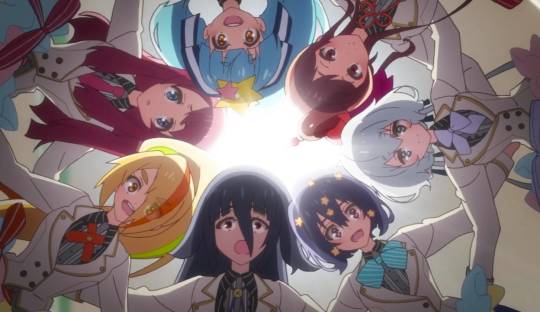
Zombie Land Saga Revenge
Quickest summary: In this sequel season, everyone’s favorite zombie idol group must claw their way back into prominence after a disastrous show- the fate of the Saga prefecture LITERALLY depends on it!
This was a fun follow-up to the first season- if you liked the first zombie-girl romp, you’ll probably enjoy this one. In fact, there were a couple areas it improved on- namely, Kotaro failed, ate crow and embarrassed himself a lot more this season, which made him more likeable (as did the fact the girls gained a lot of independence from him). This season also shed more light on what the ‘goal’ of this zombie raising project is and what kind of shit Kotaro got involved with to make this happen, and it’s appropriately off-the-wall and ridiculous. We finally got some backstory for Yugiri too! I wish it had focused on more of her interiority, but she got to be a badass in it, and it was a treat to see this zombie idol show turn into a period piece for a couple episodes (also her song ruled).
Tae also got a cute focus episode and there was a particular SMASHING performance early on! Also That revelation last season that had the potential to turn creepy hasn’t yet, and hopefully never will. The finale was heartwarming with big hints of more drama to come- I’m definitely down for more zombie hijinks!
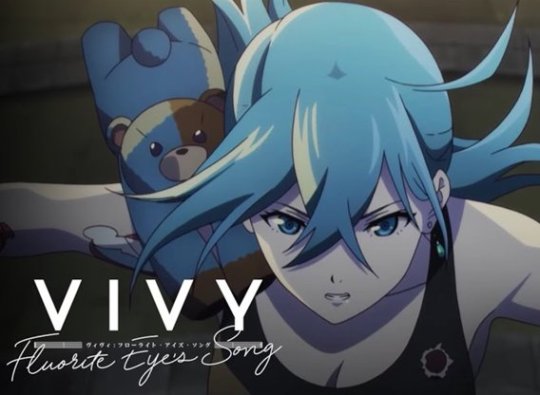
Vivy: Flourite Eye’s Song
Quickest Summary: A songstress AI named DIVA (nicknamed Vivy) is approached by another AI named Matsumoto, who says he’s from the future and they must work together to prevent AI exterminating all of humankind 100 years from now.
This show is absolutely gorgeous visually with some really nice action scenes, but when it comes to the story my feelings basically amount to a shrug. It’s fine! I guess! Vivy starts out as an interesting layered character- and I guess still is by the end- with her stoic but stubborn determination bouncing off her fast-talking bossy partner Matsumoto well. She never listens to him, which is delightful. The way the show took place over the course of 100 years was an interesting conceit as well. However, it bought up a lot of themes and then sort of... dropped them. For instance, Vivy interprets her mission (PRIME DIRECTIVE if you will) as protecting humans at all costs, no matter how destructive said humans are or what their fate is supposed to be, and is perfectly willing to murder her fellow androids to do this, showing she inherently thinks of androids (herself and her own people!) as less worthy. Which is a little alarming! There’s a very dramatic point in the show where they bring this up as a potential conflict for her character but then it’s sort of...dropped. Pretty much.
Actually, despite the premise, the show doesn’t dip into the “AI rights” as much as you think it would with the main theme being more about Vivy’s search to find her own creativity and discover what it means to ‘pour your heart into something’. Vivy herself doesn’t actually care if she has rights or anything. Which is in some ways fine, because ‘AI as an oppressed class’ has been done to death, but IT’S ALSO KIND OF IN THE PREMISE, so that means that the show just shrugs really hard at a lot of the questions it brings up basically just going “humans and AI should work together probably” and that’s it. There’s a lot that feels underexplored. The antagonists in the show also either have motivations that don’t really make sense or have boring hackneyed motivations. In the finale in particular, it feels like a lot of things happen “just because” and it falls a little flat.
I also have to warn that one of the arcs focus on a robot ‘pairing’ where the dude-coded robots actions toward his partner are straight up awful and rob her of her autonomy, but it’s played like a tragic love story. I suppose you could read it differently too, but it definitely made me go ‘ew’ the story seemed to want me to sympathize with this robo dude,
Overall, I wouldn’t anti-recommend this show, it’s an all right little sci-fic romp (and definitely SUPER pretty). My favorite element was definitely the episodes where Vivy develops an entirely new (an loveable) personality, because it played with the idea of of an AI getting “rebooted” really well and interplay between her two “selves” was done really well. But there are a lot of other parts of the show that just feel...a little underexplored and empty, making me have an ‘eh’ feeling on the show overall. It’s definitely an ambitious project, and while it didn’t quite stick the landing, there’s something to be said for a show that shoots for the stars and falls short over a show that just languishes in mediocrity.

Fruits Basket The Final
Quick summary: The final season of that dramatic drama about that weird family with a zodiac curse and the girl who loves them.
It’s very weird that after not cutting a lot out, they kinda sped through some material for, you know, the finale. I guess they thought they couldn’t stretch this final arc to 26 episodes? Or weren’t cleared for another double cour? However, though there were a couple places that felt awkward, despite being a bit condensed it mostly held together pretty well for a D R A M A T I C and ultimately heartwarming conclusion. I was really disappointed they kept the part where Ritsu cut their hair for the ‘happy ending’, I thought their intro episode not showing them in men’s clothes meant the anime had decided their presentation didn’t need to be “fixed” but WELL I GUESS NOT. That was the only big upset for me though, otherwise the adaptation went about how I expected, sticking to the source material. Furuba has a lot of bumps, from weird age gap stuff to ...gender, but it also has a lot of important feels and great character arcs. It was a gateway shoujo for many and has its important place in animanga history, so I’m glad it finally got a shiny, full adaptation.
#anime overview#spring 2021 anime#shadows house#oddtaxi#zombie land saga#fruits basket#vivy: fluorite eye's song#zombie land saga revenge#fruits basket the final#anime#my reviews#long post
68 notes
·
View notes
Text
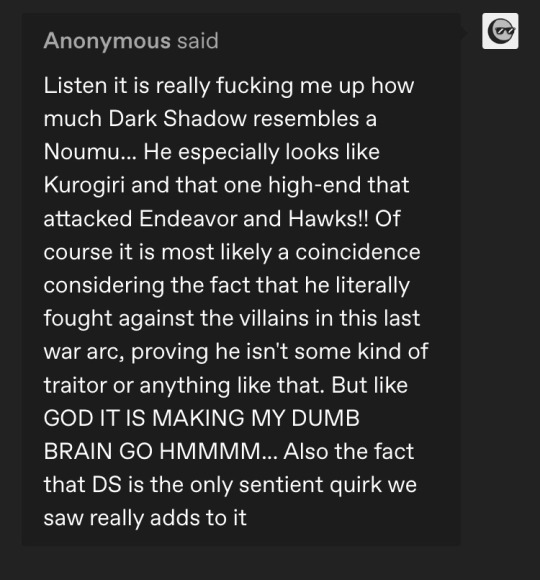
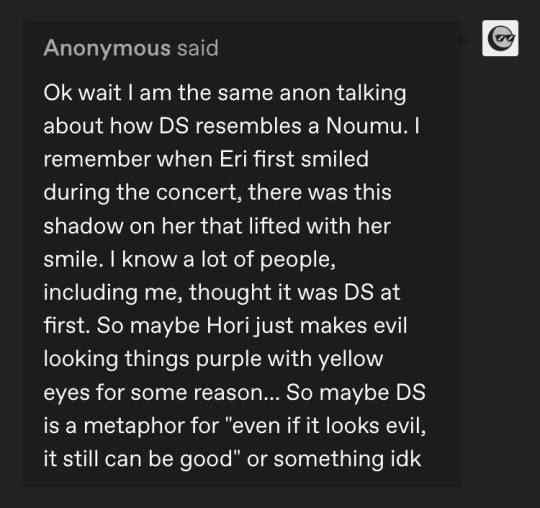
YES YES YES FINALLY I CAN TALK ABOUT THIS!
IM NOT SURE IF IVE POSTED THIS ANYWHERE ELSE BUT I THINK TOKOYAMI IS LIKE SHIROKUMO!
ANON I LOVE YOU AND YOUR GIANT NOGGIN. NOW I WILL PROVIDE YOU EVIDENCE AS TO WHY TOKOYAMI COULD BE A NOMU! I am not sure if the person who originally submitted as anon wants me to tag them in this, so I’ll be leaving them as Anon. :)
In this essay I will..
LMAO but seriously I will be comparing Tokoyami to the other advanced nomu. I’ll mostly be comparing Tokoyami and Kurogiri, as these are the most similar to each other. Spoiler from the manga ofc. Plz enjoy loves!
Anon made a fantastic point about the physical similarities between characters. The most prominent part of this theory is that Tokoyami and Dark Shadow both share many physical characteristics with the Nomu.
Tokoyami/Dark Shadow, Kurogiri, Hood, and the USJ Nomu all share very similar color schemes. This is important because Horikoshi tends to use physical appearances a lot to connect characters, even when it comes to tiny details like 2 dots on a hero costume signifying the same designer. We know that Horikoshi likes to use dark purples while drawing/designing villains. Examples include: AFO(purple + black colors), Nine(White+ Purple colors), Manga Vol 26- “Tomura Shigaraki:Origin '' Cover(Purple), Overhaul(Purple+Green colors), ect. The most advanced/high-end Nomu so far(Hood, Kurogiri, USJ Nomu) all have a color scheme of Purple/Black bodies, Yellow eyes, and some red details. Now this color scheme is actually shared between Tokoyami and Dark Shadow. Tokoyami carries the red, black, and yellow and Dark Shadow has purple and yellow.
Besides just color schemes they share physical attributes. We know that Nomu must be built off of pre-existing humans(dead or alive I believe). Most of the Nomu have some remnant of their human body, even if it is extremely beefed up or including more limbs. Kurogiri is the first Nomu we have observed that still holds his original body(his is just covered by smoke, but Shirokumo is still in there). It is entirely possible that Tokoyami’s body is technically dead, but reanimated just like Kurogiri.
Dark Shadow’s sentience is a key factor in this theory as well. He is so different from most other quirks in the series. There are only three quirks in the series that have any form of sentience. I will be focusing on Twice’s quirk, but I would like to create a separate theory for the other two. Twice’s quirk obviously creates living/sentient clones of people. However it can be argued that these clones are more like AI than actual sentient people. These quirks aren’t exactly alive and they are like AI programmed to be as similar to their source material(copied individual),therefore they will do what is most similar. Dark Shadow is a completely separate entity with completely separate emotions. We know this because there are things that Dark Shadow likes to do that Tokoyami does not, and vice versa. Many people think that Dark Shadow is a more honest extension of Tokoyami’s emotions, but not only is Dark Shadow a collection of emotions, but thoughts. In the fight against Ectoplasm, we can see that Dark Shadow is able to think and strategize on his own without Tokoyami needing to tell him what to do.
This doesn’t really count as evidence, but its something I find to be kinda sus. While at the training camp, the day of the attack Tokoyami says “Revelry in the Dark” 3 times. Its specifically pointed out as odd by Uraraka, most likely meaning that it is not something he has said before. She also seemed a bit unnerved by him saying it. I wonder if it was some kind of code phrasing to let the League know that everything was in order for the attack. Other than that, I don’t recall Tokoyami using the phrase later in the series.
Next I am going to clear up some things that might disprove the theory:
Problem: He’s far too loyal to the heroes, and he cares alot about the people around him.
It is completely reasonable that Tokoyami is faking it. This basically follows the same logic as most traitor theories. Tokoyami is known to be a very secretive individual and people don’t know too much about him. There is also a chance that he could be programmed not to know that he is a nomu/traitor, however I don’t really have any evidence for that and it seems unlikely.
Problem: He connonically has a mother, and a family...
Not too surprising, but its definitely an issue. In Vol 1, Part 3 we hear specific mentions of Tokoyami’s mother and later in the paragraph the word is family. So if he does have a family, do they/ how long have they known he’s a Nomu? There is a very little chance that they wouldn’t know, but there is a scenario in which they wouldn’t. Tokoyami could have “gone missing” when he was younger and “found” when he was older. We don’t know how long it takes to create an advanced nomu, so he could have been missing for a month to a couple years. We can speculate however, that it doesn’t take long. It only took about 4 months to alter Shigaraki, so maybe it doesn’t take too long to create an advanced Nomu. If he was young enough, he wouldn’t have a quirk and it wouldn’t be suspicious if he returned home with one. A blood test would most likely match as well, so there wouldn’t be any doubt that it was the Tokoyami family’s child. It wouldn’t be surprising if they did know. We know AFO has connections everywhere, so Tokoyami’s family could just be a fake one set up for the sake of making Fumikage look more normal.
Problem: Why has the league targeted him in the past?
Lemme explain. We’ve had two instances(that I remember) that members of the league have directly attacked Tokoyami. Once when Mr.Compress snatched him, and of course that fight with Dabi in 271. This has a simple answer, they don’t know. We know Shigaraki doesn’t tend to tell the other members stuff and usually just resorts to giving them tasks. There is a chance that Shigaraki himself might not know, but that all depends on whether or not he knows that Kurogiri is a Nomu. I don’t know if he knows but either way it doesn’t really matter.
Actually, one little tidbit about this, during the USJ attack Kurogiri sent Tokoyami to the Squall Zone. The Squall Zone is a very dark area, so fighting off villains would have been very easy for Tokoyami. So part of me believes that Kurogiri did that on purpose, and he and Shigaraki definitely do know.
I am still looking for more evidence of this theory, but this is what I have so far. If there is anymore evidence that you have found it I would love to hear! I mentioned earlier in the theory that there are two other quirks that is similar to Dark Shadow’s complete sentience. Those two quirks are AFO and OFA. There is a slight possibility that Tokoyami could have a carry-down quirk given to him by somebody else, or Dark Shadow himself is a previous user. I don’t even know where to begin on that one, but whatever.
And remember it just a theory, a bird theory! Thanks for reading!
62 notes
·
View notes
Text
The Women's Prize for Non-Fiction Shortlist is here!

I have always said that I'm not a massive non-fiction reader, hence the name of this blog. I am very selective about the non-fiction I read but some of it has been fantastic, so I'm open to reading more of it. This new book prize has been a brilliant gateway into non-fiction for me and my interest in some of the longlisted titles does seem to be growing day by day. However, to date, I have only read one of them (Wifedom) and am currently reading another (Doppelganger).
The shortlist has just been announced, so here it is!
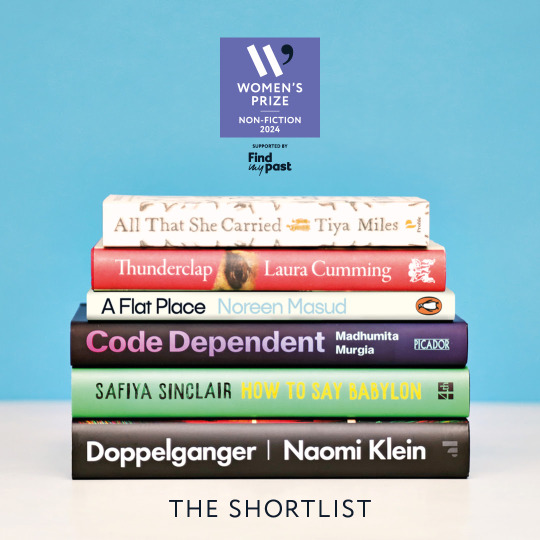
All That She Carried: The Journey of Ashley’s Sack, A Black Family Keepsake by Tiya Miles. Published by Profile Books on 13th July 2023.
Thunderclap by Laura Cumming. Published by Chatto & Windus on 6th July 2023.
A Flat Place by Noreen Masud. Published by Hamish Hamilton on 27th April 2023.
Code Dependent: Living in the Shadow of AI by Madhumita Murgia. Published by Picador on 28th March 2024.
How To Say Babylon by Safiya Sinclair. Published by 4th Estate on 3rd October 2023.
Doppelganger: A Trip Into the Mirror World by Naomi Klein. Published by Allen Lane on 12th September 2023.
I am pretty upset about Wifedom not making the shortlist because I absolutely adored it. I'm enjoying Doppelganger so far but it does take some brain power, so I'm not sure it is for everyone. I'm still interested in reading Eve by Cat Bohannon and Some People Need Killing by Patricia Evangelista. I have recently become more interested in reading Matrescence by Lucy Jones too, so I'll pick that up when I get a copy.
As you can tell, I'm not massively enthralled by this shortlist but I'm looking forward to seeing the winner being picked on 13th June. What do you think of the shortlist? Have you read any? Do you want to read any? Let me know!
0 notes